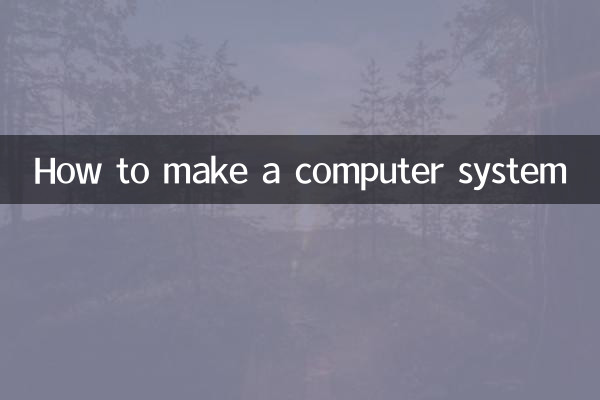How to make a computer system
In today's digital age, the creation and optimization of computer systems has become the focus of many technology enthusiasts and professionals. Whether it is an individual user or an enterprise, mastering the production methods of computer systems can improve the user experience and work efficiency. This article will combine the hot topics and hot content on the Internet in the past 10 days to introduce you in detail how to create a computer system and provide structured data for reference.
1. Basic steps of computer system production

Making a computer system is mainly divided into the following steps:
| steps | Detailed description |
|---|---|
| 1. Prepare tools | Download system image files (such as Windows, Linux, etc.) and create boot disk tools (such as Rufus, UltraISO) |
| 2. Make a boot disk | Use tools to write the system image to a USB flash drive or CD to ensure it is bootable |
| 3. Install the system | Boot from the startup disk through BIOS settings and follow the prompts to complete the system installation. |
| 4. Driver installation | Install hardware drivers to ensure proper operation of the device |
| 5. System optimization | Perform system settings and optimization according to needs, such as closing unnecessary services and installing commonly used software. |
2. Recent hot topics and hot content
According to the hot topics on the Internet in the past 10 days, the following is the hot content related to computer system production:
| hot topics | Main content |
|---|---|
| Windows 11 latest version released | Microsoft recently pushed the 23H2 update for Windows 11, which adds many new features and fixes known issues. |
| Linux distribution selection guide | Comparison and recommendation of mainstream Linux distributions such as Ubuntu, Fedora, and Debian |
| System backup and recovery | How to backup and restore your system with tools like Clonezilla to avoid data loss |
| Virtual machine installation system | Install and test different operating systems in virtual machines using VMware or VirtualBox |
3. Frequently Asked Questions
During the computer system production process, users often encounter some problems. The following are common problems and solutions:
| question | solution |
|---|---|
| The startup disk cannot be recognized | Check whether the USB disk is damaged, re-create the boot disk, and ensure that the BIOS settings are correct |
| Blue screen during installation | Update the hardware driver, check whether the system image is complete, and try to replace the installation media |
| Driver installation failed | Download the latest driver from the official website, or use driver management tools (such as Driver Wizard) to install it automatically |
| System is running slowly | Optimize startup items, clean up junk files, increase memory or replace solid-state drives |
4. Recommended system production tools
The following are recommended tools commonly used when making computer systems:
| Tool name | Function description |
|---|---|
| Rufus | A lightweight boot disk creation tool that supports multiple system image formats |
| UltraISO | Disc image file creation tool that supports editing and writing of ISO files |
| VMware Workstation | Virtual machine software that can be used to test different operating systems |
| Clonezilla | Open source system backup and recovery tool that supports full disk cloning |
5. Summary
The creation of a computer system is a process that requires patience and skill, but with the right tools and methods, users can easily complete the installation and optimization of the system. This article provides detailed step-by-step instructions, hot topics, FAQs, and tool recommendations, hoping to help you successfully complete the creation of a computer system. Whether it is a Windows or Linux system, mastering these tips will make your computer run more efficiently and stably.

check the details

check the details